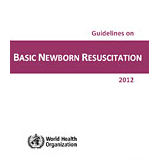
– 2012, WHO. English. French.
– This document is to provide an update to the WHO’s basic newborn resuscitation: a practical guide and to ensure that newborns in resource-limited settings who require resuscitation are effectively resuscitated. These guidelines inform WHO training and reference materials, and assist programs to develop or adapt national or local guidelines, standards and training materials on newborn care.
—
Globally, about one quarter of all neonatal deaths are caused by birth asphyxia. In this document, birth asphyxia is defined simply as the failure to initiate and sustain breathing at birth. Effective resuscitation at birth can prevent a large proportion of these deaths. The need for clinical guidelines on basic newborn resuscitation, suitable for settings with limited resources, is universally recognized. WHO had responded to this need by developing guidelines for this purpose that are contained in the document Basic newborn resuscitation: a practical guide. As this document is over a decade old, a process to update the guidelines on basic newborn resuscitation was initiated in 2009.
The objective of these updated WHO guidelines is to ensure that newborns in resource-limited settings who require resuscitation are effectively resuscitated. These guidelines will inform WHO training and reference materials, such as Pregnancy, childbirth, postpartum and newborn care: a guide for essential practice; Essential newborn care course; Managing newborn problems: a guide for doctors, nurses and midwives; and Pocket book of hospital care for children: guidelines for the management of common illnesses with limited resources. These guidelines will assist programme managers responsible for implementing maternal and child health programmes to develop or adapt national or local guidelines, standards and training materials on newborn care.